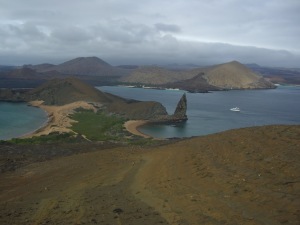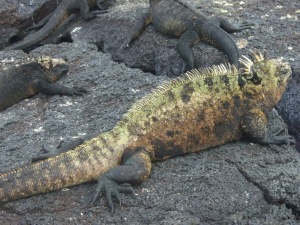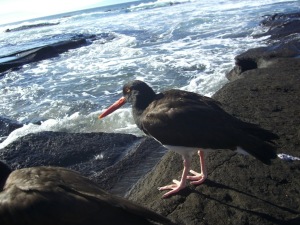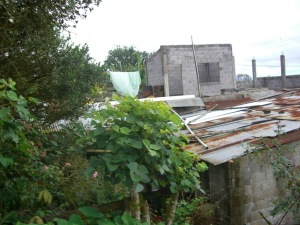 The most impressionistic visual of the 24 Galapagos Islands was the landscape. The islands, surrounded by the Pacific Ocean, survive with no natural fresh water. It must be shipped from the mainland of Chile although there are de-salting projects underway in Galapagos. All earth and rock are dry. And the effects on the environment where evolution sets the pace are curious. One island is like a trip to the moon with giant rock craters still implying bubbling cauldrons that aren’t active anymore. Some are high rugged cliffs colored by bird excrements and offering p
The most impressionistic visual of the 24 Galapagos Islands was the landscape. The islands, surrounded by the Pacific Ocean, survive with no natural fresh water. It must be shipped from the mainland of Chile although there are de-salting projects underway in Galapagos. All earth and rock are dry. And the effects on the environment where evolution sets the pace are curious. One island is like a trip to the moon with giant rock craters still implying bubbling cauldrons that aren’t active anymore. Some are high rugged cliffs colored by bird excrements and offering p recarious ledges for their nests. Others are long strips of low volcanos introduced by a border of white leafless trees that give a ghostly effect. Think aspen trees without leaves. When you get closer they are fronted by Opuntia, hairy cactus with paddles so tall as to be considered trees as well. There are no indigenous flowers left. What can be found were birthed from wayward seeds blown across the seas from the mainland or carried by birds. Since man settled, they planted their own fruits and vegetables. In green areas where mysterious caves hide petroglyphs and bats, where giant tortoises roam, wild vines of baby tomatoes cover the ground mixed up witha strange orange bell flower that is a hallucinogen which only the locals try and laugh when one asks for details.
recarious ledges for their nests. Others are long strips of low volcanos introduced by a border of white leafless trees that give a ghostly effect. Think aspen trees without leaves. When you get closer they are fronted by Opuntia, hairy cactus with paddles so tall as to be considered trees as well. There are no indigenous flowers left. What can be found were birthed from wayward seeds blown across the seas from the mainland or carried by birds. Since man settled, they planted their own fruits and vegetables. In green areas where mysterious caves hide petroglyphs and bats, where giant tortoises roam, wild vines of baby tomatoes cover the ground mixed up witha strange orange bell flower that is a hallucinogen which only the locals try and laugh when one asks for details.

All of Galapagos is volcanic, whether rust brown rock or the ever present black lava rock near the sea. It was always a hiking challenge but visually incredible. Was this the environment of dinosaurs and prehistoric animals? As it is, a freaky looking giant iguana has taken over most islands. Charles Darwin said these “lizards”, as he called them, had stupid faces. Frightening might be a better description, but they do nothing but lay around on each other on variations of lava rock and if disturbed, waddle away like a person whose belly was too fat for his legs to come together.
 Marine iguanas have manes, I guess you’d call it, from their head down to their tails, that look like pointed ivory teeth. These are formed by calcium in their meals. They love to bunch together in clusters and move away from the waters edge as the tide rolls in. Larger land iguanas live in deep holes they have dug out of dry soil in separate but equal type of communities. Believe me, as an extra, I encountered a number of geckos, and geckos don’t walk on hind legs and sell insurance in an Australian accent.
Marine iguanas have manes, I guess you’d call it, from their head down to their tails, that look like pointed ivory teeth. These are formed by calcium in their meals. They love to bunch together in clusters and move away from the waters edge as the tide rolls in. Larger land iguanas live in deep holes they have dug out of dry soil in separate but equal type of communities. Believe me, as an extra, I encountered a number of geckos, and geckos don’t walk on hind legs and sell insurance in an Australian accent.
Hiking across the black lava rock, I spent most of my time evaluating the variety of surfaces: some layers of dough ready to be baked into a croissant, other areas black petals trying to form enormous flowers, other times the lava had been pushed together into thin ridges on which you could balance your foot as you walked for a bit of reflexology. A walking stick for balance always helped, especially when you had to cross slippery lava rock freshly washed by salty waves, trying not to step on an iguana tale or touch an animal, or even catch yourself from falling by putting your hand on one of the cactus trees . Pay attention. Touch nothing. These were guide pleas.
 Galapagos Penguines
Galapagos Penguines
For the bird lover, there were endless curiosities, from trying to find all 13 of Darwin’s finches, to being inundated by frigates and gulls flying outside my stateroom at dawn, to gasping at the dive-bombing of the blue fined boobies, to identifying the American oystercatcher  with its bright red beak and black and white body, usually resting on the lava rock at the sea’s edge. Of course there was the Galapagos race of penguins to delight in and the nesting flightless cormorants with swan like necks.The seals and sea lions rolling over and stretching in the sun on every strip of sand were hard to turn away from, but they stink in groups and I already had a digital card filled with their yawns. Your first and last whiff is of Galapagos seals lying on human benches at the shaded dock where the buses deposited us
with its bright red beak and black and white body, usually resting on the lava rock at the sea’s edge. Of course there was the Galapagos race of penguins to delight in and the nesting flightless cormorants with swan like necks.The seals and sea lions rolling over and stretching in the sun on every strip of sand were hard to turn away from, but they stink in groups and I already had a digital card filled with their yawns. Your first and last whiff is of Galapagos seals lying on human benches at the shaded dock where the buses deposited us
 A sea lion saying more than it knows.
A sea lion saying more than it knows.
Even the island’s population has increased by 50 per cent in a dozen years. Most come from Ecuador to ply the tourist trade. Costs of living are high – everything must come from the mainland of Ecuador – but then wages are high, too. To be able to have a residence on one of the  four islands with settlement, one must either be born in Galapagos or marry a Galapagan. Although there is a one-strip runway airport, there is no formal harbor, so ships and yachts must anchor far away and drop their Zodiacs to come ashore. The parks do regulate what tour groups can be on what island at any particular moment. An approved ship would have a weekly schedule of visiting particular islands on particular mornings and afternoons of each day. If you missed, for example, one of those landings where the blue-footed boobies (they also have blue beaks and a crossed-eye look) hang out, you don’t get a second chance unless you stay another week.
four islands with settlement, one must either be born in Galapagos or marry a Galapagan. Although there is a one-strip runway airport, there is no formal harbor, so ships and yachts must anchor far away and drop their Zodiacs to come ashore. The parks do regulate what tour groups can be on what island at any particular moment. An approved ship would have a weekly schedule of visiting particular islands on particular mornings and afternoons of each day. If you missed, for example, one of those landings where the blue-footed boobies (they also have blue beaks and a crossed-eye look) hang out, you don’t get a second chance unless you stay another week.
But the parks get theirs as they slap a one hundred dollar fee on each arriving tourist and this money goes to preservation and conservation. Now the airport, which has been outgrown ten fold, is enlarging to handle the enormous crowds of tourists arriving on Tamu and AirGal airlines. Baltra, the dot of an island, is nothing but the single airstrip where two or three planes are allowed to set down only three or four days a week and unload curious tourists fretting to find their group. Just in case, fronting the waiting area, are enough small tourist shops eager for business. At least they are confined to the airport.

The pictures and critique are fabulous. It is almost as great as being there. Hope you are having the time of your life. Enjoy the ride!